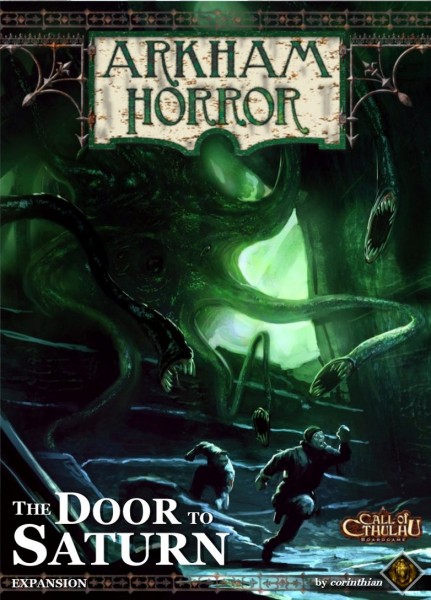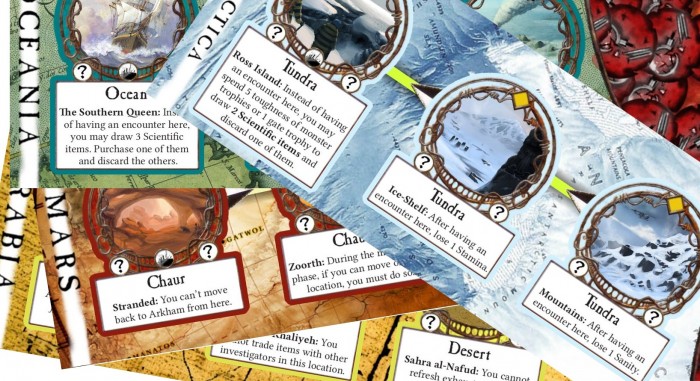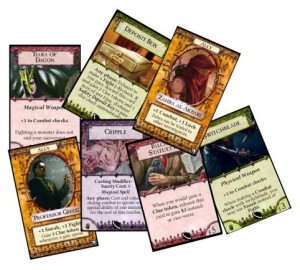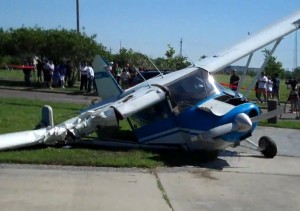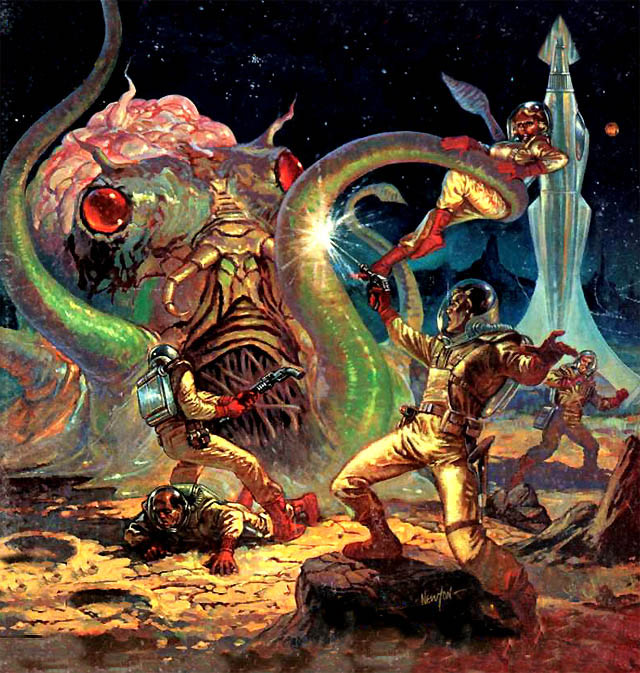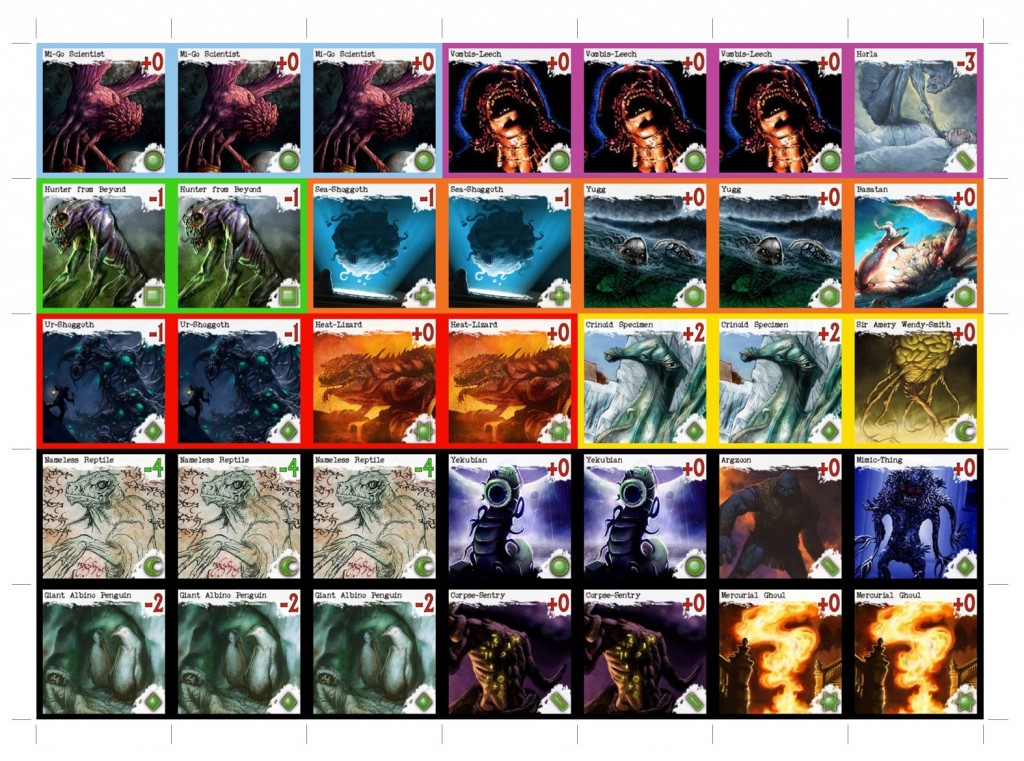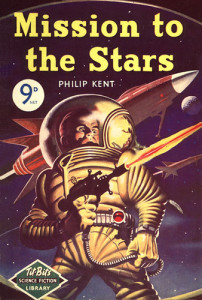You’ve sent your investigators to face the horrors and solve the mysteries of Arkham, Massachusetts.
While trying to discover the truth behind recent events they’ve faced terrors that wracked their sanity and placed their lives in peril…
They’ve been inducted into the secrets of the Silver Twilight Lodge, only to be shanked after wandering into Hib’s Roadhouse…
They’ve defeated a mind-wrenching abomination in the streets, to be shot after a misunderstanding with Deputy Dingle…
Others have gone to the remote village of Dunwich to hear more of the strange dark deeds at the Whateley Farm…
Meanwhile, people in both towns mutter furtively about the strange denizens of Innsmouth and Kinsgsport…
But what if the answers to your investigators’ questions can’t be found in shadowed New England? What if the search for answers leads them even farther out?
After playing Arkham Horror a few too times for their own sanity, many players toy with the idea of making their own investigators, often based on characters from other stories they’re familiar with.
“Could you imagine if the Watchmen were in Arkham?”
“How about SG-1?”
“The Scooby Gang?”
“Ooooh, Batman!”
When it comes to actually designing (balanced) characters for the game, most ideas, sadly, never see reality, despite access to Strange Eons, a free software that helps you make custom Arkham cards. Yet there are those intrepid few who, loving the game and wanting to put their own mark on it, go above and beyond to create whole teams of investigators, more terrifying Old Ones for them to face, and more weapons and gadgets for our brave heroes to wield.
And then there are those who go further still and release their own expansions.
Today we’re looking at The Door to Saturn, a fan-made expansion for Arkham Horror inspired partly by the writings of Clark Ashton Smith. Most Arkham Horror storylines take place in or around Massachusetts, reflecting much of the original source material. But while H.P. Lovecraft was the creator of the Mythos, others have added to and expanded it – admittedly to mixed response.
One such writer was Smith, a contemporary and friend of Lovecraft. Both were most well known contributors to the magazine Weird Tales, which published most of Lovecraft’s work. The two often corresponded, and characters and events published in one author’s stories sometimes appeared in the other’s. Once such a crossover was as a direct sequel.
Clark Ashton Smith’s stories were marked by his overly detailed descriptions of death and decomposition, and his fantastical science fiction. This expansion borrows more from the latter. Some of the art and encounters draw heavily from pulp science fiction of the 1920’s-30’s, in all it’s bizarre glory. That is, it strayed a bit from the 20’s that was to what the 20’s thought it could be. But while the tone might seem different at first glance, make no mistake: this is still Arkham Horror.
“Opening the Box”
 Enough with background and inspiration; let’s move on to what this expansion does. First – and most importantly – is the change regarding Clue tokens. Whenever a Clue token is spent, discarded, or removed from anywhere, it is not returned to the supply. Yes, that means there is a finite amount of Clue Tokens in the game, representing the finite amount of answers Arkham itself can supply. Removed Clues are placed in the “Lost Clues” area of your new Expedition Board.
Enough with background and inspiration; let’s move on to what this expansion does. First – and most importantly – is the change regarding Clue tokens. Whenever a Clue token is spent, discarded, or removed from anywhere, it is not returned to the supply. Yes, that means there is a finite amount of Clue Tokens in the game, representing the finite amount of answers Arkham itself can supply. Removed Clues are placed in the “Lost Clues” area of your new Expedition Board.
These boards are new additions to the game. Remember all those encounters at the University that referenced artifacts brought back from expeditions? Now the investigators can go on these travels themselves!
At the start of the game, you choose one of the four Expedition Boards and put it near the table, placing the Travel Office token on the River Docks. Any investigator may spend one Movement at the River Docks to journey to the Travel Office on the Expedition map. This will end your movement. When on an expedition, players are not treated as though they are in Arkham, but they are not “Out of World” either. Investigators on an Expedition Board receive encounters during the Arkham Encounters phase as normal, drawing from that Expedition’s provided Encounter Deck.
You may notice that each location has the same name, such as Antarctica’s Tundra. That is because explorers do not know where the Lost City is: they must find it. So, no matter which location you are at in Antarctica, you will continue to have Tundra encounters until, through an encounter, you discover a new location which may replace the one you are currently on. Each expedition has 16 Encounter Cards, many of which allow players to recover lost Clue Tokens or gain a new type of Item class called Scientific.
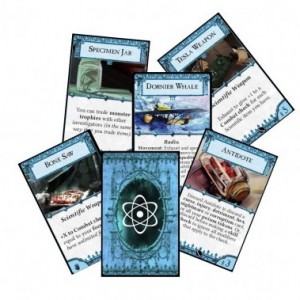 Scientific items represent technology used or found by investigators in the dark corners of the world. Much like Unique items, they should be highly sought after.
Scientific items represent technology used or found by investigators in the dark corners of the world. Much like Unique items, they should be highly sought after.
While the rewards can be great, though, journeying to the edge of civilization is fraught with peril. There are reasons mankind is not flourishing there, and those reasons try to keep it that way. Expect your encounters to be as dangerous, if not more so, as those in Arkham.
In fact, the locations themselves will have unwelcome effects on your investigator due to their inhospitable conditions. If you find yourself on expedition to the Antarctic, be prepared to lose Stamina or Sanity every turn on the Ice Shelf or Mountains. If you explore Arabia, the desert heat and isolation will take its toll, while the storms of Oceania will lose you your hard-won items.
And if you accidentally step through a portal and find yourself unable to breathe on Mars, your trip may be one way…
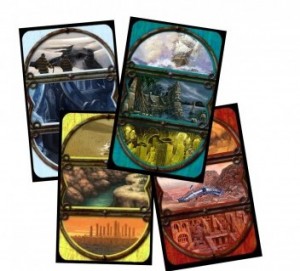 There should be no surprise here – along with these new treasures and perils come new monsters! Twenty-one new monsters to be exact, and they can be brutal. Some will have Scientific Resistance or Immunity to counter your new weapons, while others have plain old Weapon Resistance and some come with new abilities.
There should be no surprise here – along with these new treasures and perils come new monsters! Twenty-one new monsters to be exact, and they can be brutal. Some will have Scientific Resistance or Immunity to counter your new weapons, while others have plain old Weapon Resistance and some come with new abilities.
The first is Unnameable, which prevents you from adding Clue tokens to your Horror or Combat checks against that creature. The second is Poisonous. Whenever you fail a Combat check against a creature with this ability, you don’t lose Stamina. Instead, you gain a Poison counter. If the number of Poison counters you have ever equals your maximum Stamina, you are devoured.
Plus, you get four new Ancient Ones to test all these newfangled items out on.
So, all told you’re getting:
12 new locations (3 used at a time)
64 Expedition Encounter cards (16 used at a time)
4 new Ancient Ones
35 new monsters (21 individual, some duplicates, including Special monsters to be used with a specific Ancient One)
12 Sinister Plot cards (used with Kingsport’s Epic Battle)
10 new Mythos cards
20 new Unique Items
20 new Common Items
40 Scientific Items
10 new Spells
7 new Allies
51 counters for Poison, Travel Office, and use with a specific Ancient One
All For the Low Low Cost of Nothing But Your Sanity
Did I mention that its provided free? That all you have to do is print it out and play?
Despite being fan-made effort, the quality of the story and situations matches that of the original game. You can clearly see a lot of time and effort went into its creation. The art is Mythos appropriate and perfectly serves to add flavor wherever it’s needed, whether on items, monsters, allies, etc. The creatures and abilities, while tough, seem well balanced, and the author even provides a page showing which stories each item, monster, or character comes from.
The new mechanics regarding Clue tokens make sense, and the expansion provides a way for dealing with the problems it creates. Now, in none of the games I played was an Ancient One ever in danger of awakening due to Clue tokens, but it’s interesting to even have to consider the possibility. I swapped which investigators were on expedition, partly to transfer my new Scientific Items and gathered Clue tokens into Arkham, and partly to save their lives.
The Expedition boards are great. It’s halfway between a small and big box expansion. Traditionally, the only problem with Dunwich, Kingsport, etc., is that you often have to keep a dedicated investigator up there just to keep things under control, and only rarely is a second sent up to help out or even interact with the surroundings. With Expeditions being smaller, it’s easier to maintain flow between two areas, and someone on an expedition can easily come back without repercussions.
Of course, unless you’re on Mars. Then, well, what are you going to do?
The Scientific items are a decent flavor addition. Some, like the Field Radio and Antidote, make sense thematically. Others, like the Shock Glove and the Astro Suit, require a bit of stretching.
Take the Disintegrator: One Handed, +5 to Combat Checks, but you can’t keep monsters defeated with it as trophies.
It’s powerful but somewhat balanced. Others are entertaining in different ways, like the Dornier X-3, a plane you can exhaust during movement to fight a monster in the Outskirts or the Sky. I can kind of see how that might work.
There’s also the Dornier Whale, which exhausts and uses 2 Movement to move you from any location not “out of world” to any street in Arkham. That one’s a little strange to imagine being used constantly, but it somehow fits
I enjoyed the twist given by the few items of “futuristic” technology. Likely for the same reasons I enjoy Sci Fi Channel Original movies, I have no objection to a dash (but not overdone) of nostalgic camp. This is especially true in a setting where strange creatures are pouring out from interspatial/ temporal / dimensional rifts as a prelude to the arrival of an entity of interstellar or interdimensional origins.
Yes, the Mythos of Arkham is primarily horror, and the fact that these beings you are to fight are so beyond our understanding that merely their impending presence strips us of our sanity is an integral part of the atmosphere. If the heavier science fiction emphasis is a little too jarring for your liking, all you need to do is remove a few of the Scientific Items (you’ll know which), remove Mars as an Expedition choice, and you’ll still have most of this expansion’s content without changing that sense of inevitable doom.
Another issue you may run into is combining this expansion with the game components you already have. Obviously, when you print it you may not have access to the same cardboard material the official releases have. Thus, you will be able to feel if items or monsters are from this expansion or not. It is worth a try, however.
Take advantage of the aligned front and back sheets for the cards. This will allow you to print them out on card stock or paper with card backing or laminating. You could even use packing tape: the poor man’s laminate. Depending on where you have printing access, there could be a slight cost to printing them right, but the effort is worth it.
Doing a Digital Run
To ensure this was an expansion worthy of pring, the first time I played I left all the images in their folder on my computer, and I did the following:
- I brought up the image of the Ancient One I was using and left it up on screen, writing down its information on some notebook paper. I put his doom tokens there, clearly. Gluing them to the screen seemed like a bad idea.
- Whenever I drew a card type that had new additions, I rolled a die. If I rolled low, I drew from the old deck. If I rolled high, I rolled again to randomly determine what I got:
- There are 20 new Common and Unique Items, so I rolled a d20 and counted off the sheet to find mine.
- Since there are 10 Spells and Mythos cards, I did the same with a d10.
- There are 16 encounters for each Expedition, so I rolled a d4 twice: once to determine which group of four to choose from, the second selecting the specific card in that group.
- There are 40 Science items, so if I drew one, I rolled high or low for Group 1 or 2, then rolled a d20 to select a specific item in that group.
- I found that jotting down important information on a note card or sticky pad to keep track of items in front of me or monsters on the board worked, and I could always reference the files or just latest Mythos card if needed.
- Because there are only 10 new Mythos cards, you might want to draw a new one only on a 5 or 6 – possibly just a 6 if you plan to try each Expedition, as I found that otherwise you get them all on your first session.
Of course, this is the super-cheap way of testing to see if the expansion is worth the possible printing effort. I will state that, yes, it certainly is, and recommend you give it a try.
Your Destiny Awaits
The author’s download site has the free .eon files through his Dropbox, and exported images in a separate link for those without Strange Eons (He continually updates the cards as he receives feedback from players. Most of these changes are reflected in the .eon files. The image forms are not updated as often.)
In addition, as of this writing the rules are not in the image files either, so we have provided a copy.
Oh, and by the way: Saturn has absolutely nothing to do with this. He “just thought it was a good name”…
If you have your own expansion or variant, feel free to drop a message, and we’d love to give it a spin! In the meantime …
Ia! Ia! Cthulhu ftaghn!
![]()
Nathan Crocco is a regular contributor to the site. If you have particular game variants you wish to request of him, he can be reached at nathan@cardboardrepublic.com.
You can discuss this article over on our forums!
Photo Credits: Airplane by tburke504; Mission to the Stars cover by Ron Turner; “Unknown Worlds of Science Fiction Special” art by Don Newton.

